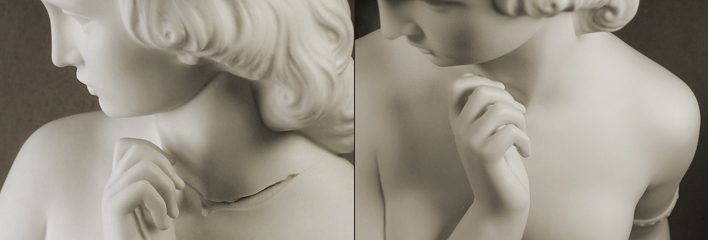Porcelain, Terracotta, Ceramic, China, Pottery Restoration and Conservation.
Grashe Seattle Art Restorers' unique method for porcelain and ceramic restoration.
Fills on ceramics have a long history, associated either with covering up an adhesive line or replacing a large loss. Numerous materials have been employed in loss compensation, from thickened adhesives, pastes, and putties to substituted fragments from other vessels and cast resins and waxes. Many of the early materials and methods of filling losses can be classified as “obsolete”.
It is often said in science that theories can never be proved before experimental work has been performed. So, we experiment with our own method for many years using our 30 years experience and knowledge in art history and fine art conservation and restoration.
By mixing several organic and non organic ingredients with light curing composites we have developed different materials that are used as adhesives and paste very similar to porcelain that hardens by ultraviolet light with help of temperatures as low as 150° F.
In case of large (percentage wise) missing fragments, we manufacture ceramic/porcelain replacements by modeling lost fragments in wax, making a mold, and then removing the wax by porcelain either by conventional method using kiln or using our own technique, whatever is more suitable for the best possible result.
By combining old world craftsmanship with state-of-the-art technology, we bring damaged objects of art back to life.
When restoration is complete it will be absolutely impossible to see the difference between restored and original surfaces.
Porcelain Types and History.
There are three types of porcelains-hard paste, soft paste and bone. All hard-paste porcelains are made of kaolin clay and glazed with a feldspar solution. Pieces of it are cold to the touch; the glaze does not scratch; and the colors of under-glaze decoration are not absorbed into the bisque.
These hard-paste porcelains were fired at very high temperatures, above 2,400° F. Body and glaze were completely fused, as can be seen if one examines a broken piece. This type of porcelain was made by the Chinese from very early times and when examples, especially those with cobalt blue under-glaze decoration, reached Europe in quantity, early in the seventeenth century, they were admired and eagerly sought after. Soon efforts were made to imitate the Chinese porcelain. These started with the Medici china, produced in Italy during the sixteenth century, and continued with that made at Meissen in 1713, at various French porcelain factories during the eighteenth century, and from about 1745 by such English potteries as Bow, Chelsea, Derby and Worcester.
Practically all of these were soft-paste porcelains with slightly varying artificial compounds of white clay and powdered “frit” (pulverized glass) substituted for the natural kaolin used by the Chinese. The term, soft paste, is used to designate the European attempts to simulate Chinese porcelain; pieces made of it are warmer to the touch, scratch fairly easily, and are slightly porous, and if it is chipped the fractures are not as flake-like as in hard-paste porcelains. Also, in soft-paste porcelains the colors of any under-glaze decoration tend to be absorbed into the bisque.
Soft-paste porcelains were fired twice, first unglazed and then after being coated with whatever glazing was used at a particular pottery. Temperatures for firing were about 1,900° F. These porcelains were made in increasing quantities by Continental and English potteries until after discoveries of sizable deposits of kaolin in Saxony, in the south of France and in Cornwall, which took place about 1770. After this, potters gradually changed to making hard-paste porcelain.
Bone china, the third type of porcelain, was an English development. It was perfected about 1800 in Staffordshire by Josiah Spode, 11, son of the founder of the Spode pottery. To a mixture of white clay and feldspar he added burned cattle bones. This resulted in a body that was halfway between the hard paste of Chinese origin and the soft paste developed in Europe, and it required but one firing. It was such a practical and economical solution of the porcelain-formula problem that within ten years bone china had become standard with all English potteries. It is translucent, its glaze is free from the hard, glasslike quality of the Chinese product, and it does not chip as easily as either of the other two kinds of porcelain.



























